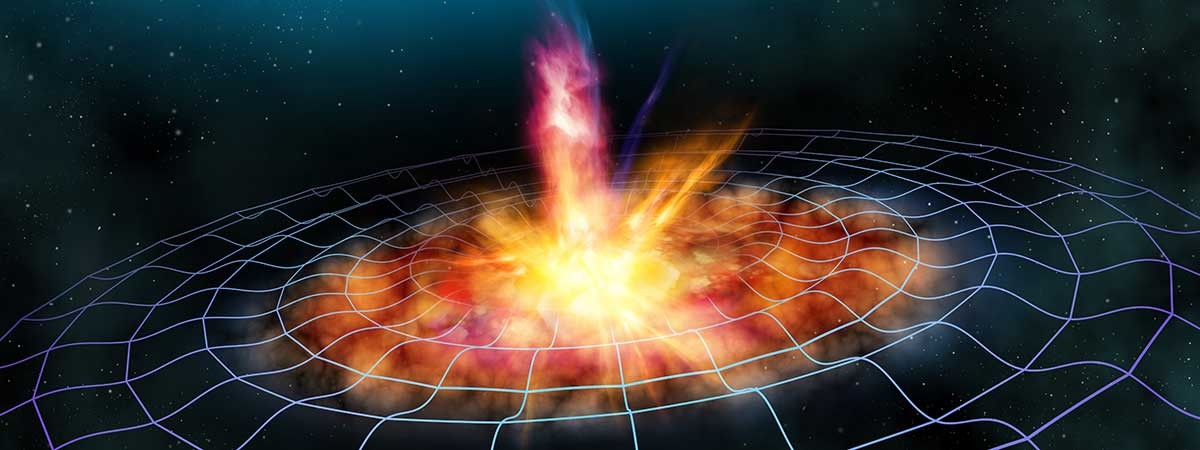Over a century ago, Albert Einstein had already predicted the existence of gravitational waves. But their existence was only actually proven in 2015. Two kilometre-long vacuum tubes were used as detectors.
Just as a stone thrown into water ripples the water's surface, gravitational waves stretch and compress space. This rippling of space-time is caused by cosmic catastrophes like exploding stars or colliding black holes. The gravitational waves then spread at the speed of light. At least that was what Albert Einstein predicted in 1915 when he introduced his theory of general relativity.
However, the existence of the mysterious waves was pure theory until 2015, because they are extremely hard to measure. They alter space for the blink of an eye, and only by a fraction of the diameter of an atom. The collision of two massive black holes provided direct evidence of gravitational waves one hundred years after they were predicted.
Kilometre-long measuring devices
These waves had rippled through space-time for two billion years before they very slightly warped the form of space-time on Earth on 14 September 2015. Two identical LIGO detectors (LIGO = Laser Interferometer Gravitational Wave Observatory) located 3000 kilometres apart were able to measure these in the USA.
They each consist of two tubes at a 90-degree angle. One of them is two, the other is four kilometres long. Where the two sides meet, a laser beam is emitted and divided in half by a beam splitter. Then half of the beam is directed into each of the tubes. Power-recycling mirrors ensure that the light speeds back and forth many times before it returns to the beam splitter after a total distance of 1120 kilometres. If a gravitational wave passes through space, one arm of the interferometer stretches while the other one compresses. This leads to a detectable change in the intensity of the laser beam.
Vacuum and measurement accuracy
To ensure that the measurement devices are able to work completely fault-free, the tubes are at a pressure that is one trillionth of the air pressure at sea level. To do this, the tubes are initially heated for 30 days, then subsequently the remaining air is extracted with high-performance vacuum pumps. Finally, ion pumps are used to extract the remaining gas molecules. In the resulting ultra-high vacuum, there are no air molecules to deflect the laser beam or cause the mirrors to vibrate, and there is no dust that could diffuse the light.
In February 2016, after extensive calculations, the participating scientists were able to announce that they were actually able to measure gravitational waves and confirmed Einstein's theory. For their work on this project, pioneers Rainer Weiss, Barry C. Barish and Kip Thorne received the Nobel Prize for Physics in 2017.

With vacuum to the Nobel Prize
Huge vacuum tubes help prove the existence of gravitational waves
What do gravitational waves have to do with dark matter?
Beginning with the first measurement in 2015, gravitational research has since registered further ripples in space-time. The last one was on 14 August 2017. It was detected by Virgo, a detector with a similar construction located near Livorno in Italy, which has recently begun cooperating with LIGO. The source was a stellar collision that took place about 1.8 billion light years away. The researchers hope to gain access to new information about history and the physics of the universe that was previously inaccessible. Furthermore, the detectors may be able to find indications of dark matter, although this doesn't actually have anything to do with gravitational waves.
Until now, the existence of dark matter is just a theoretical postulate – just like the existence of gravitational waves was until recently. Astrophysicists refer to their measurement results and calculations to conclude that galaxies would be ripped apart by the centrifugal force of their rotation if dark matter didn't exist. Its mass must be five times as large as that of visible material.
With the LIGO and Virgo detectors, astronomers can not only locate black holes, but also "hear" what they have to say about the birth of galaxies. One theory about dark matter namely states that it consists of "primordial" black holes created by the big bang. Even if this hypothesis represents a minority opinion among physicists, the gravitational detectors can provide data that either supports or refutes it so that science can focus on other explanatory models.
Beginning with the first measurement in 2015, gravitational research has since registered further ripples in space-time. The last one was on 14 August 2017. It was detected by Virgo, a detector with a similar construction located near Livorno in Italy, which has recently begun cooperating with LIGO. The source was a stellar collision that took place about 1.8 billion light years away. The researchers hope to gain access to new information about history and the physics of the universe that was previously inaccessible. Furthermore, the detectors may be able to find indications of dark matter, although this doesn't actually have anything to do with gravitational waves.
Until now, the existence of dark matter is just a theoretical postulate – just like the existence of gravitational waves was until recently. Astrophysicists refer to their measurement results and calculations to conclude that galaxies would be ripped apart by the centrifugal force of their rotation if dark matter didn't exist. Its mass must be five times as large as that of visible material.
With the LIGO and Virgo detectors, astronomers can not only locate black holes, but also "hear" what they have to say about the birth of galaxies. One theory about dark matter namely states that it consists of "primordial" black holes created by the big bang. Even if this hypothesis represents a minority opinion among physicists, the gravitational detectors can provide data that either supports or refutes it so that science can focus on other explanatory models.